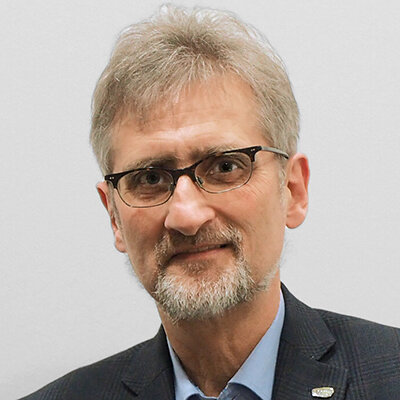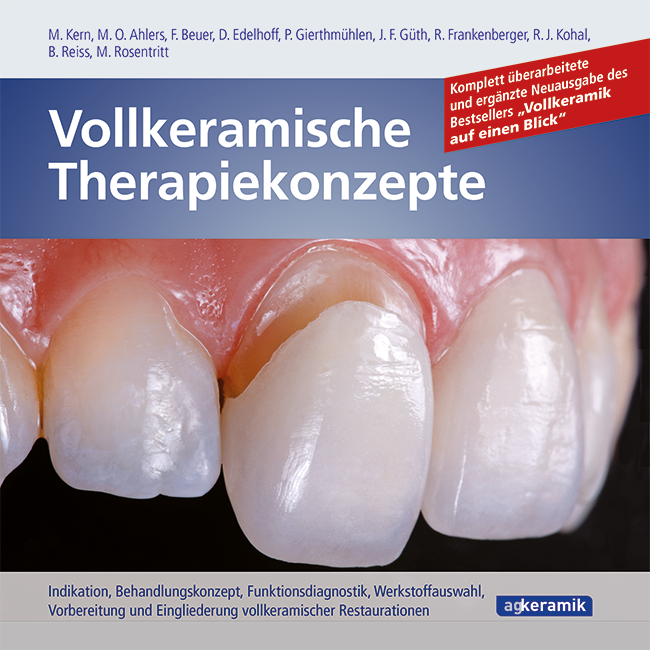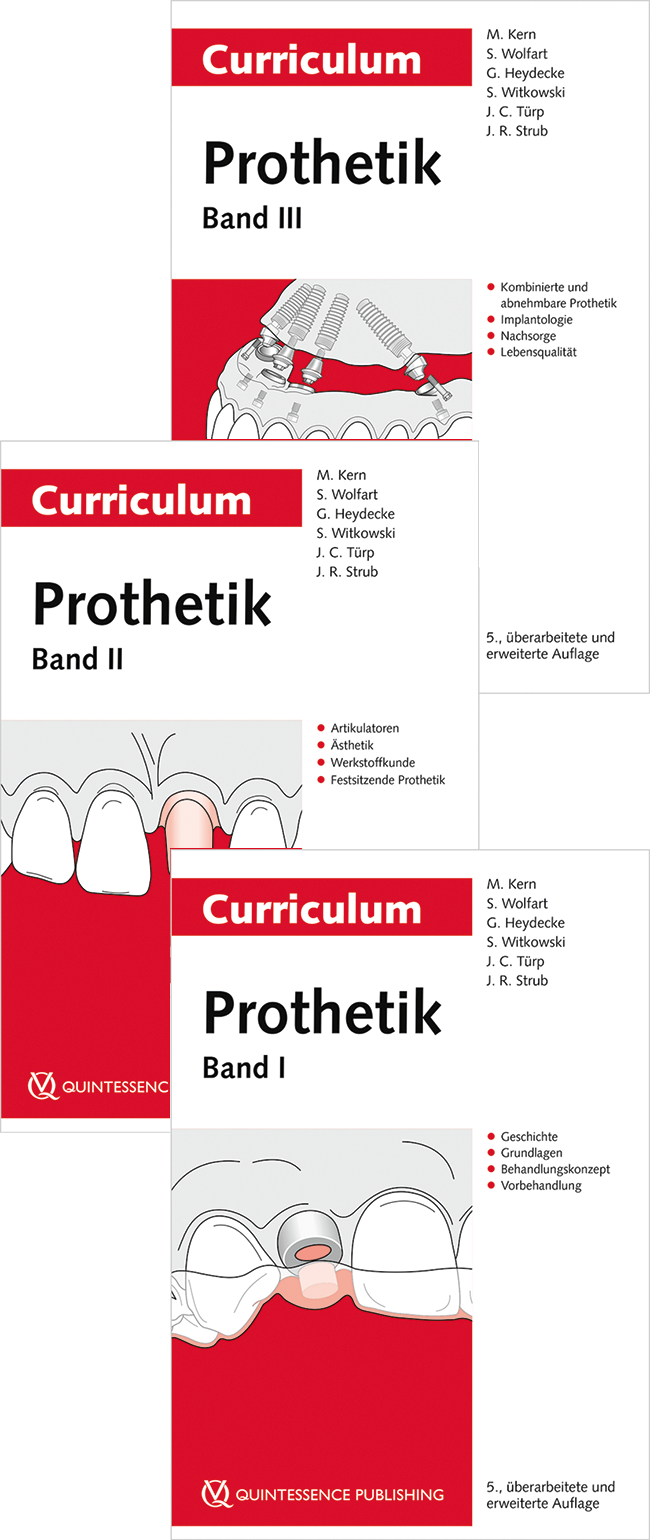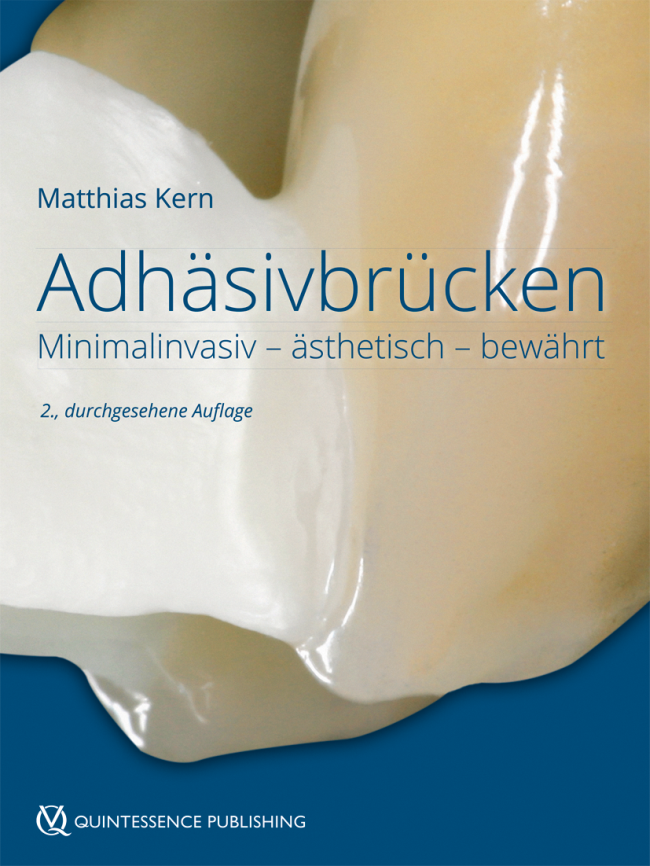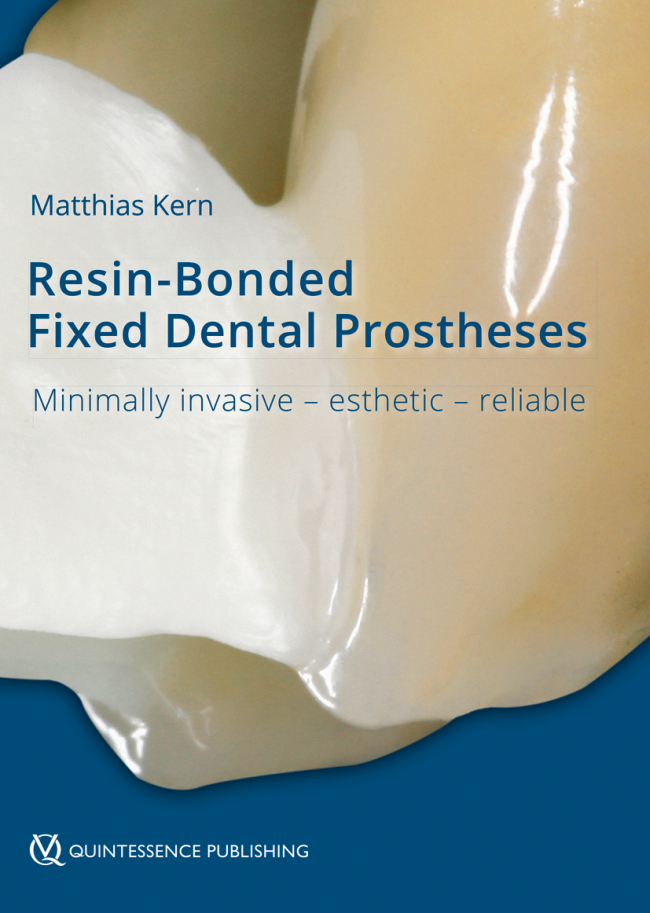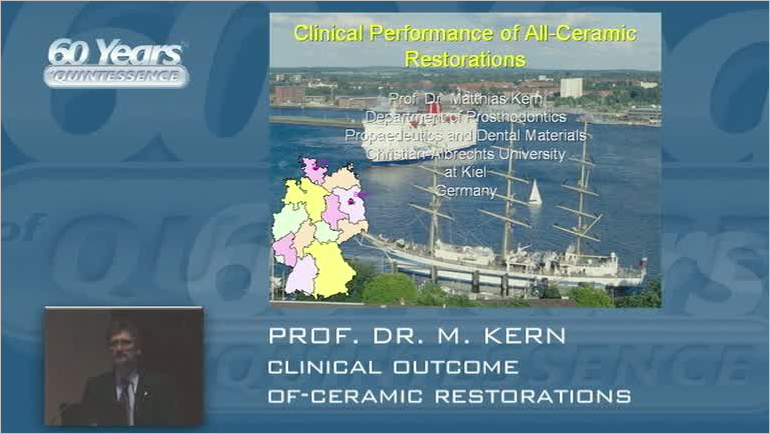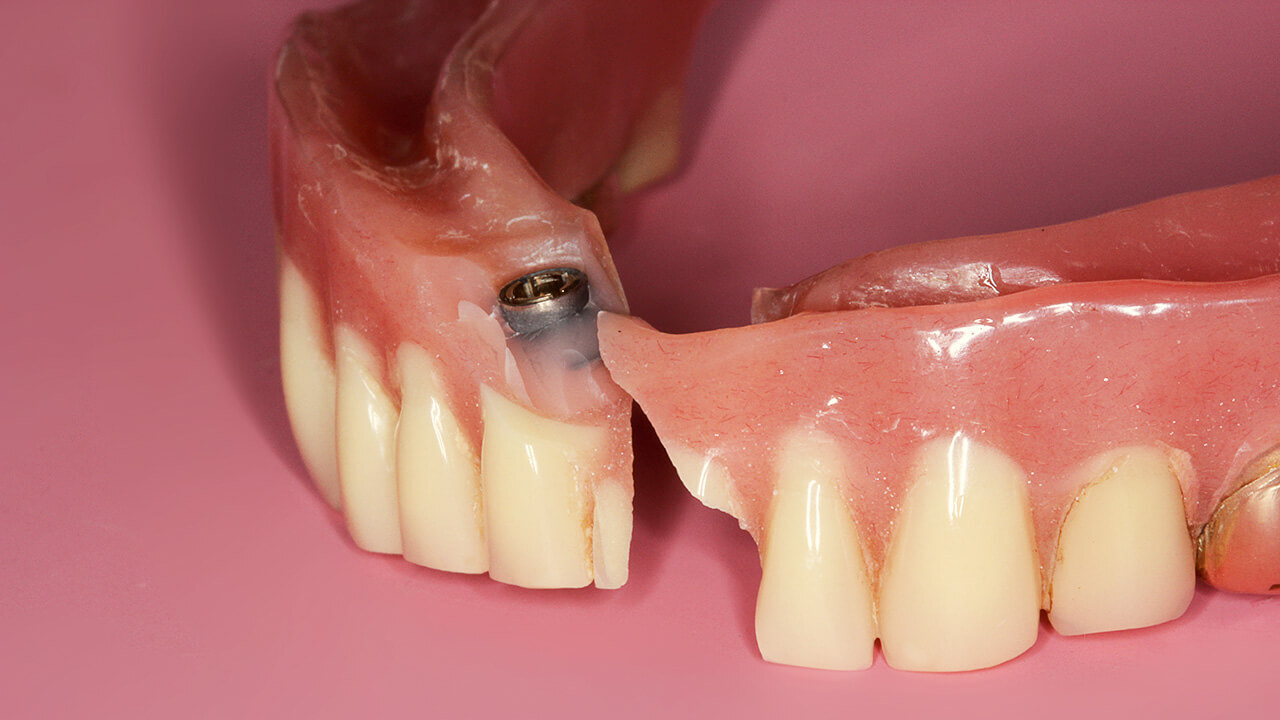Implantologie, 4/2024
Pages 367-368, Language: GermanKern, MatthiasInternational Journal of Computerized Dentistry, 3/2024
ScienceDOI: 10.3290/j.ijcd.b4200857, PubMed ID (PMID): 37417447Pages 273-280, Language: English, GermanElsayed, Adham / Farrag, Gasser / Chaar, Mohamed Sad / Yazigi, Christine / Abdelnabi, Nouran / Kern, MatthiasAim: The objective of the present study was to investigate the effect of using different materials for the fabrication of implant abutments and crowns on the mechanical behavior of implant-supported single crowns after artificial aging. The materials were tested in different combinations to reveal whether using stiff or resilient materials as an abutment or a crown material might influence the fracture strength of the whole structure. Materials and methods: A total of 40 implants (blueSKY) were restored with identical custom-made CAD/CAM abutments milled out of lithium disilicate or ceramic-reinforced polyetheretherketone (PEEK) and divided into five test groups (n = 8). Forty crowns made of three different materials (zirconia, lithium disilicate, and ceramic-reinforced PEEK) were used to restore the abutments. Specimens were subjected to mechanical loading up to 1,200,000 cycles in a chewing simulator (Kausimulator) with additional thermal cycling. The surviving specimens were subjected to quasi-static loading using a universal testing machine (Z010). Results: The PEEK abutments with zirconia crowns showed the highest median failure load (3890.5 N) while the PEEK abutments with lithium disilicate crowns exhibited the lowest (1920 N). Fracture and deformation occurred in both the crowns and abutments. Conclusion: The failure load of the restorations was influenced by the material of the abutment and crown. Restoring PEEK abutments with zirconia crowns showed a high failure load and no screw loosening.
Keywords: CAD/CAM, custom-made implant abutment, implant abutment, lithium disilicate, PEEK, zirconia
QZ - Quintessenz Zahntechnik, 2/2024
WissenschaftPages 172-177, Language: GermanElsayed, Adham / Meyer, Gunnar / Wille, Sebastian / Kern, MatthiasZiel der in diesem Beitrag beschriebenen Studie war es, die Bruchfestigkeit vollanatomischer Kronen aus drei verschiedenen Zirkonoxidtypen mit unterschiedlichem Gehalt an Yttriumoxid zu bestimmen. Es zeigte sich, dass die mechanischen Eigenschaften der Zirkonoxidkeramik darunter leiden können, wenn der Yttriumoxidgehalt erhöht wird, um die optischen Eigenschaften zu verbessern. Das transluzentere 5Y-TZP wies dennoch eine sehr hohe Bruchfestigkeit auf, die 3000 N überstieg. Die Ergebnisse dieser Studie legen nahe, den Einsatz von Zirkonoxid mit hohem Yttriumoxidgehalt in Bereichen oder Situationen mit hohen Belastungen sorgfältig abzuwägen.
Keywords: Zirkonoxid, Keramik, künstliche Alterung, Yttriumoxid
Implantologie, 2/2024
Pages 209-220, Language: GermanWolfart, Stefan / Kern, MatthiasBehandlungserfolg nach 20 JahrenDieser Fallbericht zeigt die prothetische Rehabilitation eines älteren Patienten mit einer Parodontitis im Stadium IV, Grad A. Es lagen verkürzte Zahnreihen im Ober- und Unterkiefer sowie zusätzliche Schaltlücken im Unterkiefer vor. Die prothetische Rehabilitation erfolgte vor 20 Jahren prinzipiell schon gemäß den Empfehlungen der aktuellen europäischen Leitlinie zur Versorgung bei Zahnverlust im Stadium IV der Parodontitis. Das Hauptaugenmerk dieses Fallberichtes liegt auf der prothetischen Rehabilitation und der Langzeitbewährung zweier einflügeliger Adhäsivbrücken im Unterkieferfrontzahnbereich, wobei die entsprechenden Pfeilerzähne schon vor 20 Jahren einen Attachmentverlust von ca. 60−70 % aufwiesen. In den jährlichen Nachuntersuchungen sind neben einer unterstützenden Parodontitistherapie lediglich kleinere restaurative Maßnahmen notwendig geworden. Sowohl die parodontale Situation als auch die prothetischen Versorgungen sind über den Beobachtungszeitraum von 20 Jahren stabil. Es sind keine weiteren Zähne verloren gegangen.
Keywords: Parodontitis, Stadium IV, Adhäsivbrücke, Implantattherapie, verkürzte Zahnreihe, Langzeiterfolg, Langzeitbeobachtung, Fallbericht
Quintessenz Zahnmedizin, 2/2024
ImplantologiePages 107-111, Language: GermanHosseinkhah, Payam / Al-Nawas, Bilal / Kern, MatthiasManuskripteingang: 10.09.2023, Manuskriptannahme: 16.10.2023
Keywords: Elektrotomie, Hochfrequenz (HF)-Chirurgie
Qdent, 2/2024
FokusPages 22-32, Language: GermanKern, MatthiasDieser Beitrag beschreibt, warum einflügelige Adhäsivbrücken bei traumatischen Schneidezahnverlusten schon im Kindes- und Jugendalter und bei Nichtanlagen im Jugendalter eine hervorragende minimalinvasive Versorgungsmöglichkeit von Schneidezahnlücken darstellen. Der frühzeitige Ersatz eines traumatisch verloren gegangenen bleibenden Schneidezahns durch eine einflügelige Adhäsivbrücke im Kindesalter scheint den Erhalt des zahnlosen Kammbereichs zu begünstigen und erlaubt gleichzeitig eine ggf. notwendige kieferorthopädische Therapie, beinhaltet aber andererseits nicht das Risiko einer Wachstumshemmung durch die Verblockung von Zähnen. Bei Nichtanlagen bieten einflügelige Adhäsivbrücken eine Möglichkeit zum Ersatz der fehlenden Zähne in Einzellücken, sobald die ggf. notwendige kieferorthopädische Therapie abgeschlossen ist. Eine oft Jahre andauernde provisorische Lückenversorgung mit all ihren Nachteilen kann durch den frühzeitigen Einsatz von Adhäsivbrücken vermieden werden. Zwar ist die Behandlung mit Adhäsivbrücken techniksensitiv, aber bei richtiger Indikationsstellung und adäquatem Vorgehen sind die erzielten Ergebnisse äußerst zuverlässig.
The Journal of Adhesive Dentistry, 1/2024
Open Access Online OnlyResearchDOI: 10.3290/j.jad.b5200039, PubMed ID (PMID): 3860228611. Apr 2024,Pages 93-102, Language: EnglishArslan, Tuğba / Wille, Sebastian / Kern, MatthiasPurpose: To investigate the influence of contamination and different cleaning methods on resin bonding to cobalt-chro-mium (CoCr) alloy disks.Materials and Methods: A total of 160 CoCr disks were divided into 3 groups. The first group (N = 64) was air abraded with alumina particles; the second group (N=64) was air abraded and contaminated with silicone disclosing agent and saliva; the third group (N = 32) was neither air abraded nor contaminated. The first two groups were divided into 4 subgroups (N = 16) according to the cleaning method: ultrasonic bath in 99% isopropanol, use of a cleaning suspension of zirconium oxide particles, use of a cleaning suspension based on 10-MDP salt, and treatment with atmospheric plasma. The third group was divided into 2 subgroups (N = 16): treatment with atmospheric plasma and no treatment. All CoCr specimens were bonded to plexiglas tubes filled with a bonding resin that contained phosphate monomer. Tensile bond strength (TBS) was examined by tensile testing after 3 and 150 days of water storage plus 37,500 thermal cycles (N = 8).Results: After contamination, TBS was significantly reduced after 150 days of water storage. Groups without air abrasion showed initially low TBS and debonded spontaneously after 150 days of water storage.Conclusion: None of the cleaning methods was able to remove saliva and silicone disclosing agent on CoCr-alloy sur-faces. Surface activation by plasma treatment has no long-term effect on the bond strength.
Keywords: alloy, contamination, cleaning, bonding, plasma treatment
The Journal of Adhesive Dentistry, 1/2024
Open Access Online OnlyClinical ResearchDOI: 10.3290/j.jad.b5883893, PubMed ID (PMID): 3968795117. Dec 2024,Pages 283-292, Language: EnglishTürp, Lisa / Nehrke, Lucas / Schadte, Philipp / Siebert, Leonard / Kern, MatthiasPurpose: The purpose of this laboratory study was to evaluate common materials for isolation and neutralizing agents for hydrofluoric acid (HF). Additionally, surfaces of lithium disilicate ceramic were examined for precipitates after the etching and neutralizing process.
Materials and Methods: The HF permeability of the following isolation agents (n=8) was investigated by positioning them over pH indicator paper under airtight conditions and applying 9% HF: latex rubber dam; elastic plastomer rubber dam; nitrile gloves; latex gloves; liquid rubber dam; Teflon; AZ strip. Four neutralizing agents were tested (n = 8): calcium carbonate plus chlorhexidine gel; calcium hydroxide; calcium D-gluconate monohydrate plus chlorhexidine gel; IPS neutralizing powder plus water. Each agent was mixed with HF, according to a calculated ratio, followed by determining the pH value. Forty lithium disilicate ceramic specimens were divided into five groups (n=8), according to the etching and neutralizing protocol, and examined for precipitates by scanning electron microscopy (SEM) and energy-dispersive X-ray (EDX) analysis.
Results: All isolation agents were impermeable to HF, except for Teflon. HF could be neutralized with neutralizing agents under laboratory conditions, with mean central pH values ranging from 6 to 11. Assessment with SEM showed precipitates on surfaces when neutralizing with calcium hydroxide only. EDX analysis confirmed residues of calcium fluoride among others.
Conclusion: All tested isolation agents, except for Teflon, seem suitable for clinical use. When using calcium hydroxide for neutralizing, precipitates could remain on the surface of lithium disilicate ceramic.
Keywords: acid etching, glass-ceramic repair, hydrofluoric acid, intraoral repair, isolation agent, lithium disilicate ceramic, neutralization, neutralizing agent
Implantologie, 1/2024
Pages 3, Language: GermanKern, MatthiasThe International Journal of Prosthodontics, 6/2023
DOI: 10.11607/ijp.7468, PubMed ID (PMID): 38109392Pages 712-721, Language: EnglishSamran, Abdulaziz / Mourshed, Bilal / Ahmed, Mohammed A. / Al-Akhali, Majed / Kern, MatthiasPurpose: To evaluate the effects of post length, post material, and substance loss on the fracture resistance of endodontically treated mandibular premolars. Materials and Methods: A total of 96 extracted human mandibular first premolars were endodontically treated and divided into 12 test groups (n = 8 each) based on the number of residual walls (one/two), post material (glass-fiber/titanium), and post length (5 mm, 7.5 mm, and 10 mm). After luting the posts, specimens received a composite resin core and a crown preparation with a 1.5-mm ferrule. Cast cobalt-chromium crowns were cemented using glass-ionomer cement. After 1,200,000 chewing cycles with a load of 49 N and simultaneous thermocycling (5°C to 55°C), specimens were quasi-statically loaded at 30 degrees to the longitudinal axis of the tooth until fracture. Fracture loads were analyzed using three-way, two-way, and one-way ANOVA (α = .05). Fracture modes were examined under a stereomicroscope (×25 magnification) and recorded. Results: The mean ± SD fracture loads ranged from 642 ± 190 N (one wall, glass fiber, 5 mm) to 1,170 ± 130 N (two walls, titanium, 7.5 mm). The mean fracture load of titanium posts was significantly higher than that of glass-fiber posts (P < .001), and the 7.5-mm post length exhibited significantly higher fracture loads than groups with 5-mm and 10-mm post length (P = .008). Conclusions: Teeth restored with titanium posts revealed considerably higher fracture resistance than teeth restored with glass-fiber posts, especially if 7.5-mm–length posts were used.



